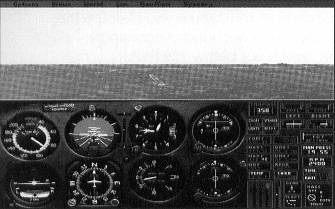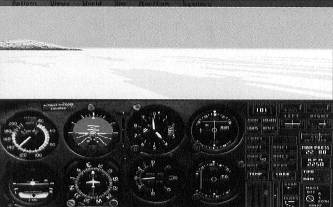Microsoft Flight Simulator Handbook
by Jonathan M. Stern
DME ARC Transition
Some IAPs use a curved path, instead of a straight path, to lead into the final approach course. So, for example, two of three IAFs on the VOR/DME Rwy 35 IAP to Olympia, Washington, are on DME arcs. In order to fly the DME arc, the airplane must be equipped with DME and VOR equipment.
Flying a DME arc is a little bit trickier than it first appears, because it requires continual heading changes until the final approach course is intercepted. Although the IAFs are denoted at the ends of the arc, as drawn, the DME arc may be intercepted at any point along the published arc. It is not necessary to intercept the arc at the outer limit where IAF appears.
The procedure, then, is to fly along the arc until reaching the final approach course. Because the airplane continues to cover ground during a turn, you should lead the turn onto the final approach course by 1/2 mile if your groundspeed is less than 150 knots. At higher speeds, a longer lead may be necessary.
The lead distance must be estimated because there is no instrumentation in the airplane that tells you the distance to the final approach course while on the DME arc.
A good way to estimate the lead is by knowing the VOR radial you are on and leading by a number of degrees. Each degree is approximately 100 feet per nautical mile from the transmitter. Because one-half nautical mile is approximately 3,000 feet, divide the distance of the arc into 30 to get the number of degrees by which to lead the turn. For example, on a 15 nautical mile arc, lead by two degrees. On a 10 nautical mile arc, lead by three degrees.
On some IAPs that use a DME arc, lead radials are published, Rather than estimating the distance by which to lead the turn onto the final, a specific point in space is indicated for beginning the turn to final, If a lead radial is published to turn off the DME arc and onto the final approach course, you may begin the descent to the published altitude for the approach after crossing the lead radial.
When, as here, a lead radial is not published, descent from 4,000 feet to 1,600 feet may not be initiated until the airplane is actually established on the final approach course,
Follow these steps:
- If you are paused at Flight Simulator having just missed the approach to runway 35, pick up from there. If you quit Flight Simulator at the end of the last section, open the Olympic Event situation now.
- In either case, you want to raise the cloud ceiling so that, when you execute the IAP a second time, you can complete the approach and land. Accordingly, reprogram the clouds now so that the base level is not below 780 feet.
- Unpause and climb to 4,000 feet while tracking outbound on the OLM 356° radial.
- Upon reaching 2,000 feet, start a climbing left turn to 4,000 and track directly to the Olympia VORTAC.
- Track outbound from Olympia on the 100° radial and set the power controls for cruise flight.
- When you get to approximately 14.5 DME, turn right to 200 degrees. Because you continue to travel Eastward as you turn, you need the one-half mile lead. Figure 18.15 shows this scenario.
- By turning 100° to the right, you should stay within one mile of the arc. Rotate the OBS all the way around until the needle centers with a TO indication. Keep the needle centered so that you can keep track of which radial you are on and turn the airplane 10° to the right every time you have traveled 10° to keep the airplane's heading 100° to the right of the radial that you are passing.
Remember that the radial you are passing is the reciprocal of the OBS setting when you have a TO indication.
- You must include both the NAV 1 display and the DME readout in your instrument scan. If the DME reading is greater than 15, make a 10-degree correction to the right to get back on the arc. If the DME readout is less than 15, make a 10-degree correction to the left.
- As you approach the inbound course, remember to lead the turn onto final by two degrees—in other words when passing the 174° radial. Pace your turn to the inbound heading so that you roll out on the inbound heading as the needle centers with the OBS set to 356°.
- When you are established on the inbound course, you are authorized to descend to 1,600 feet and should slow to approach speed. At SCOOT, you can descend to 780 feet, the MDA. (See Figure 18.16.)
Figure 18.16. The spot plane view of your airplane passing SCOOT.
- The missed approach point is .5 DME before reaching the VORTAC. This time, however, you should break out of the clouds just in time to see the runway and land. (See Figure 18.17.)
Figure 18.17. The landing runway is just barely in sight from the MDA as the airplane passes through a thin cloud layer.

Table of Contents
Previous Section: VOR-DME Approach
Next Section: Circling Approach
